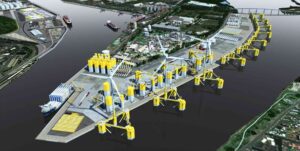A prototype of a world-first 100 per cent recyclable wind turbine blade has been produced at a manufacturing facility in Spain, marking a new milestone for the Zero wastE Blade ReseArch (ZEBRA) consortium behind the project and a big step towards “closing the loop” for wind power.
The 62 metre turbine blade was designed and built by LM Wind Power – a subsidiary of the renewables arm of GE – following a year of material development and testing and sub-component level process trials.
Its production marks a milestone for the Zebra team, established in 2020 as a partnership led by French research center IRT Jules Verne and a group of companies including Arkema, Canoe, Engie, LM Wind Power, Owens Corning and Suez.
The consortium’s goal has been to demonstrate the technical, economic, and environmental relevance of thermoplastic wind turbine blades on a full scale, with an eco-design approach to facilitate recycling.
The prototype turbine blade was made using Arkema’s Elium thermoplastic resin and glass fabrics from Owens Corning, all of which can be chemically recycled, where the resin is “depolymerized” – a process that separates the fiber from the resin and recovers the materials to be reused.
In a statement on Friday, LM Wind Power said it would now start full-scale structural lifetime testing of the prototype blade at its Test and Validation Centre in Denmark, to verify its performance. Once those tests were finished, the end-of-fife recycling methods would also be validated.
The next steps will be the recycling of production waste, the dismantling and recycling of the blade and the analysis of the test results.
By the end of 2023, the consortium hopes to have met the challenge of bringing the wind energy sector into the circular economy loop.
“Work on the Zebra project is progressing according to schedule, which has all the necessary expertise for the deployment of sustainable thermoplastic wind turbine blades,” said Céline Largeau, project manager at IRT Jules Verne.
“The manufacture of this first blade is a great success for the entire consortium and for the wind industry in general,” Largeau said.
“With this project we are addressing two crucial industry challenges,” added John Korsgaard, senior director of engineering excellence at LM Wind Power.
“On one hand, we are progressing on our Zero Waste Blades vision by preventing and recycling manufacturing waste.
“On the other, we are taking blade recyclability to a new level: the end-of-life thermoplastic composite blade material has high value in itself and can be readily utilised in other industries as material compounds but can also be depolymerised and the resin reused in the production of new blades.”










